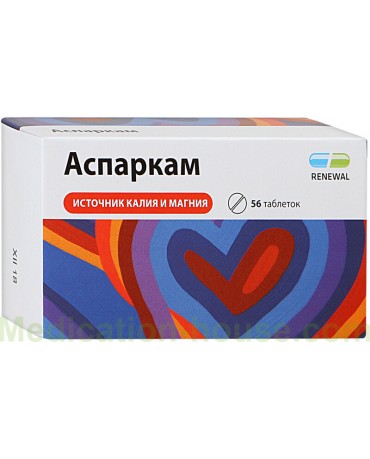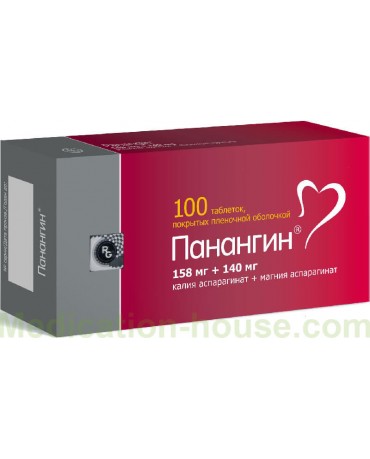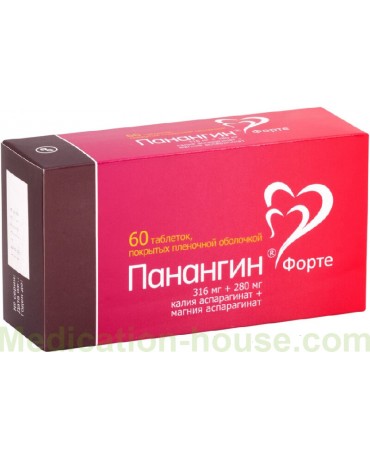Instruction for Panaspar
Reed more and buy Panasparon this page
Panaspar is a drug that replenishes the lack of potassium and magnesium in the body.
Release form and composition
The drug is produced in the form of film-coated tablets: biconvex round (158 mg + 140 mg) or oval (316 mg + 280 mg), shell and core on a cross section of almost white or white (10 pcs. In a blister, in a cardboard box 2 or 5 packs and instructions for use of Panaspar).
1 tablet (158/316 mg + 140/280 mg) contains:
active substances: potassium asparaginate hemihydrate - 166.3 / 332.6 mg (in terms of potassium asparaginate - 158/316 mg); magnesium asparaginate tetrahydrate - 175/350 mg (in terms of magnesium asparaginate - 140/280 mg);
additional components: potato starch, colloidal silicon dioxide, corn starch, povidone (medium molecular weight polyvinylpyrrolidone, K-30 povidone), magnesium stearate, talc;
film shell: butyl methacrylate copolymer, stearic acid, hypromellose (hydroxypropyl methylcellulose 6 cP3), titanium dioxide, sodium lauryl sulfate, talc, triacetin.
Pharmacodynamics
Potassium (K +) and magnesium (Mg2 +) cations are the main cations of the intracellular fluid, which play a key role in the functioning of a large number of enzymes, the formation of bonds between intracellular structures and macromolecules, as well as in the mechanism of muscle contraction. To a large extent, the contractility of the heart muscle depends on the intra- and extracellular ratio of calcium, potassium, sodium and magnesium ions.
Endogenous asparaginate, due to its high affinity for cells, as well as a result of weak dissociation of its salts, acts as a carrier of potassium and magnesium ions, ensuring the penetration of the latter into the intracellular space in the form of complex compounds.
Potassium asparaginate and magnesium asparaginate help to improve metabolic processes in the myocardium. Magnesium / potassium deficiency can cause the development of cardiac pathologies such as arterial hypertension, coronary atherosclerosis, metabolic changes in the myocardium and arrhythmias.
Pharmacokinetics
Magnesium asparaginate and potassium aspartate are rapidly absorbed in the intestine, mainly in the small intestine. Active substances are eliminated by the kidneys.
Indications for use
Panaspar is recommended for use as part of complex therapy to eliminate the lack of potassium and magnesium against the background of the following diseases:
chronic heart failure (CHF);
ischemic heart disease (CHD) (including acute myocardial infarction);
cardiac arrhythmias, including arrhythmias associated with an overdose of cardiac glycosides.
Contraindications
Absolute:
atrioventricular block (AVB) of I – III degree;
shock, including cardiogenic - blood pressure (BP) below 90 mm Hg. Art .;
chronic and acute renal failure;
Addison's disease;
hypermagnesemia, hyperkalemia;
violation of amino acid metabolism;
acute metabolic acidosis;
hemolysis;
severe myasthenia gravis;
dehydration of the body;
age under 18;
hypersensitivity to any component of the drug.
The drug should be used with extreme caution during pregnancy (especially in the first trimester) and during lactation.
Instructions for use
Panaspar tablets should be taken orally after meals, since the acidic environment of the stomach weakens the therapeutic effect. They must be swallowed whole, without chewing or breaking, drinking plenty of water. Before starting therapy, you need to consult a specialist.
The drug should be taken 3 times / day, when using a dosage of 158 mg + 140 mg, 1-2 tablets, when using a dosage of 316 mg + 280 mg - 1 tablet each.
Maximum daily doses of Panaspar: for a dosage of 158 mg + 140 mg - 6 tablets; for a dosage of 316 mg + 280 mg - 3 tablets.
Side effects
During therapy, the following adverse reactions may occur: in patients with cholecystitis or anacid gastritis - nausea, diarrhea, vomiting, burning or discomfort in the epigastric region; paradoxical reaction (increased number of extrasystoles), AVB, hyperkalemia (vomiting, diarrhea, nausea, paresthesia), hypermagnesemia (thirst, facial flushing, hyporeflexia, lowering blood pressure, convulsions, respiratory depression).
If any of these side effects worsen or new adverse reactions develop, you should consult your doctor.
Overdose
With an overdose of Panaspar, the risk of developing hyperkalemia and hypermagnesemia increases.
The main symptoms of hyperkalemia can be excessive fatigue, paresthesia, confusion, myasthenia gravis, heart rhythm disturbances (AVB, bradycardia, arrhythmias, cardiac arrest). The main symptoms of hypermagnesemia include nausea, vomiting, decreased blood pressure, decreased neuromuscular excitability, and lethargy. In the case of a sharp increase in the level of magnesium ions in the blood, such reactions as suppression of deep tendon reflexes, respiratory paralysis and coma may appear.
With the development of intoxication, symptomatic treatment is prescribed, including the administration of calcium chloride intravenously at a dose of 100 mg / min. If necessary, the blood is purified by hemodialysis.
Special instructions
With diseases occurring with hyperkalemia, during the period of Panaspar therapy, patients need regular monitoring of the plasma potassium content in the blood.
Influence on the ability to drive vehicles and complex mechanisms
Studies of the effect of the drug on the ability to drive a car and other complex equipment have not been conducted. It is not assumed that Panaspar will have a negative impact on the psychophysical functions of a person.
Application during pregnancy and lactation
During pregnancy, the drug can be taken only if the expected benefit to the woman far outweighs the potential threat to the fetus.
Since potassium and magnesium asparaginates are excreted in breast milk, if it is necessary to treat with the drug during lactation, it is necessary to stop breastfeeding.
Childhood use
For persons under 18 years of age, Panaspar therapy is contraindicated due to the lack of data confirming the efficacy and safety of taking the drug in patients of this age category.
With impaired renal function
Patients suffering from chronic / acute renal failure are contraindicated in the tablets.
Drug interactions
glucocorticosteroids: hypokalemia caused by the intake of these drugs is eliminated due to the action of potassium;
angiotensin-converting enzyme inhibitors, heparin, nonsteroidal anti-inflammatory drugs, cyclosporine, β-blockers, potassium-sparing diuretics (spironolactone, triamterene): the threat of hyperkalemia is aggravated, up to the appearance of asystole and arrhythmia;
antiarrhythmic drugs: the negative dromo- and batmotropic effect of these drugs increases;
cardiac glycosides: their undesirable effects are reduced due to the action of potassium;
decamethonium, atracurium, suxamethonium, succinyl chloride (depolarizing muscle relaxants): neuromuscular blockade may increase;
polymyxin B, neomycin, streptomycin, tetracycline: the effects of these antibiotics are weakened;
anesthetics: increase the inhibitory effect of magnesium on the central nervous system;
calcium supplements: reduce the effects of magnesium supplements;
calcitriol: increases the plasma level of magnesium in the blood;
drugs that exhibit an enveloping and astringent effect: the absorption of potassium asparaginate and magnesium asparaginate in the digestive tract decreases; in combination therapy, the interval between taking Panaspar and these drugs should be at least 3 hours.
Terms and conditions of storage
Store out of the reach of children at a temperature not exceeding 25 ° C.
Shelf life is 2 years.
Terms of sell
You can buy Panaspar without a prescription from a doctor.




